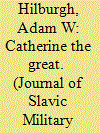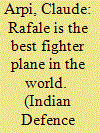| Srl | Item |
| 1 |
ID:
132462


|
|
|
|
|
| Publication |
2014.
|
| Summary/Abstract |
The campaigns of Catherine the Great against the Ottoman Empire in the 1770s reveal key characteristics of operational art. Catherine's campaigns serve as an example of lesser-known conflicts that fulfill the necessary conditions of the numerous schools of thought on operational art. The operational commander, Rumiantsev, developed an operational plan to meet the strategic directives developed by Catherine's permanent 'Council attached to the Court'. His armies used successive tactical actions to engage Turkish maneuver forces and lay siege to its fortresses. The armies were organized into combined arms corps that coordinated to remain mutually supporting with the ability to concentrate at the decisive point when required and the Russian armies to not fight in the linear methods of its Western counterparts. Additionally, the armies and corps conducted distributed operations throughout the theater of war, at times hundreds of kilometers separating them. More importantly, Rumiantsev arranged tactical actions to achieve strategic objectives, the most important part of the definition of operational art. These successive, distributed operations should satisfy the schools of thought that consider Napoleon's campaigns as operational art, but those that understand operational art beginning with Grant and Moltke may see that the Russian Campaigns on the frontiers also move beyond the classical strategy of a single point
|
|
|
|
|
|
|
|
|
|
|
|
|
|
|
|
| 2 |
ID:
133037


|
|
|
|
|
| Publication |
2014.
|
| Summary/Abstract |
Appointed as the Air Force Chief of Staff (CEMAA) on September 17, 2012, at the age of 53, General Denis Mercier had joined the French Air Force academy in 1979 and qualified as a fighter pilot in 1983. With 182 combat missions and more than 3,000 flying hours (mostly on Mirage F1C and Mirage 2000C) throughout his career, he has acquired extensive experience both as an operational commander and as a fighter pilot. In 2008, he was appointed Commander of the French Air Force Academy in Salon de Provence. Prior to becoming Air Chief, he was posted as a senior Military Advisor in the Ministry of Defence.
Claude Arpi met him on his return from Jodhpur where the Indo-French joint exercises 'Garuda V' were being held. That day, General Mercier flew a Sukhoi-30 MKI, while his Indian counterpart, Air Chief Marshal Arup Raha flew a Rafale. Excerpts from the Interview
|
|
|
|
|
|
|
|
|
|
|
|
|
|
|
|